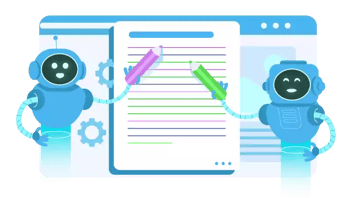Elevate your content with HubSpot Marketing Hub for content marketing. Discover how our strategies and HubSpot's tools drive success.
13 Habits of Effective Content Creators for 2025
Content marketing is praised as the strategy of the hour, year, or decade. Content marketing has a proven track record of driving sales and business growth. Yet surprisingly, few are doing content marketing. And fewer still are doing it well. But what do content creators do to be effective?
Here are some habits to acquire and nurture to become more effective, stand out among content creators, and bring more of the power of content marketing to your business.

Why Does Content Creation Matter?
-
92% of marketers say content marketing is effective. Content marketing proves to be a valuable asset for businesses, regardless of their size.
-
B2C businesses that create high-quality content see a 4.5x increase in website traffic. Producing high-quality and pertinent content for your intended audience is crucial.
-
B2B businesses that create high-quality content see a 3.5x increase in lead generation. Content marketing can potentially be a highly effective method for generating leads.
-
70% of consumers say they would rather learn about a product or service from a company's blog than from an advertisement. This statistic highlights the importance of blogging as a core component of a successful content marketing strategy.
-
Social media is the most popular channel for consuming content. Businesses must prioritize creating optimized content for social media platforms.
By leveraging these trends, businesses can develop effective content marketing strategies that will help them reach their target audience and achieve their marketing goals.
1. Set clear goals and objectives
Setting clear goals and objectives is an important habit of effective content creators because it helps them stay focused and ensures that their content is aligned with their overall objectives. Having a clear idea of what they want to achieve with their content allows content creators to plan and create targeted and relevant content for their audience. They define SMART goals, measure the success of their content, and determine if they are meeting their goals.
Example: A content creator may aim to increase brand awareness for their company. They may create blog posts or social media posts highlighting the company's products and services to achieve this goal. By setting this goal and aligning their content with it, the content creator can ensure their efforts are directed towards achieving their desired outcome.
2. Read and Research
Researching thoroughly is a habit of effective content creators because it helps them produce accurate, well-informed content that their audience will find valuable. Good research involves gathering information from various sources, including primary sources (such as original research or data) and secondary sources (such as articles, books, or other published works).
Effective content creators take the time to research their topics thoroughly, using a variety of methods such as:
- Interviewing experts or industry insiders
- Analyzing data and statistics
- Reviewing primary and secondary sources
- Conducting online searches to find relevant information
By taking the time to research their topics thoroughly, content creators can create accurate and reliable content, which helps to establish credibility and build trust with their audience. It also allows them to present new and unique perspectives on their topics, making their content more interesting and engaging.
Find the blogs your audience reads and read them as well.
3. Write consistently
Being consistent is an important habit of effective content creators because it helps them build a loyal audience. Consistency can refer to several different things, such as:
- Posting content regularly (e.g., daily, weekly, etc.)
- Maintaining a consistent brand voice and tone
- Using consistent formatting and design elements in their content
By being consistent, content creators can establish a sense of predictability and reliability for their audience. This can help build trust and foster a sense of community around their content, leading to increased engagement and loyalty from their audience.
Example: If a content creator consistently posts high-quality blog posts every Monday, their audience will come to expect new content from them on that day and may make a habit of checking back for updates. This consistency can help to build a loyal following over time.
4. Know your audience - "Define your buyer persona"
Knowing your audience is essential to effective content creation because it allows you to create relevant and valuable content for your buyer persona. When you understand your audience's needs, interests, and pain points, you can create content that addresses these issues and delivers value to your readers. This can help to increase engagement and build a loyal following.
Here are a few ways that knowing your audience can help with content creation:
-
It allows you to tailor your content to your audience's needs: By understanding what your audience is looking for, you can create content that addresses their needs and interests.
-
It helps you choose the right tone and style: Knowing your audience can also help you choose the right tone and style for your content. For example, if you target a younger audience, you may want to use a more casual and conversational tone. In contrast, a more formal tone may be more appropriate if you target a more professional audience.
-
It helps you choose the proper format: Different audiences may prefer different formats for consuming content. By understanding your audience's preferences, you can select the right format (e.g., blog post, video, podcast) to deliver your message.
-
It helps you promote your content effectively: Knowing your audience can also help you choose the correct channels for promoting your content. For example, if your audience is active on social media, you may want to focus on promoting your content on those platforms.
Understanding your audience is essential for creating content that resonates with them and delivers value.
5. Keep the End Goal in Mind
Keeping the end goal in mind is essential to effective content creation because it helps ensure your content is aligned with your overall objectives. By having a clear idea of what you want to achieve with your content, you can create targeted and relevant content for your audience, which can help increase engagement and drive desired outcomes.
You Might Also Like This Post:
Here are a few ways that keeping the end goal in mind can help with content creation:
-
Create a plan: By having a clear idea of what you want to achieve with your content, you can create a plan for how to achieve it. This can include deciding on the topics to cover, the format of the content, and the promotion plan.
-
Stay focused: Keeping the end goal in mind can also help you stay focused on the most important aspects of your content. This can help you avoid getting sidetracked or going off on tangents, which can help to make your content more effective.
-
Measure success: Having a clear end goal in mind can also help you measure the success of your content. You can track your progress and determine if your content achieves the desired results by setting specific, measurable goals (e.g., increasing website traffic by 20%).
6. Use analytics
Using analytics can be a valuable tool for effective content creation because it allows you to gather data about your audience and your content, which can help you make informed decisions about your content strategy. Some specific ways that you can use analytics for effective content creation include:
-
Measuring content performance: By analyzing data about your content (such as page views, time spent on a page, and engagement metrics), you can determine which types of content are most popular with your audience and adjust your strategy accordingly.
-
Identifying opportunities for improvement: Analyzing data can also help you identify areas where your content could be improved. For example, if you notice that your bounce rate is high for a particular page, you may want to consider revising the content to make it more engaging.
-
Understanding your audience: Analyzing data about your audience (such as demographics, location, and behavior) can help you create content that is more relevant and valuable to them.
-
Determining the best channels for promotion: By analyzing data about how your content performs on different channels (such as social media, email, or your website), you can determine which channels are most effective for promoting your content and allocate your resources accordingly.
Using analytics can be a powerful tool for effective content creation. It allows you to make data-driven decisions about your content strategy and optimize your efforts to achieve your goals.
7. Strategize and plan ahead
If you have a team, take the time to meet daily. It will pay off in your results. And if you're a content marketing team of one, the same advice applies; just call it evaluation instead of a strategy meeting. You have a documented editorial mission statement, a documented content marketing strategy, and a solid handle on effective content marketing. Take time daily to evaluate your efforts and see how well those efforts match up with your documented strategy and expectations.
Some specific ways that content creators can plan include:
-
Creating an editorial calendar: An editorial calendar is a schedule that outlines the topics and dates for publishing content. By creating an editorial calendar, content creators can plan their content and ensure they have a steady stream of content to publish.
-
Outlining content: Many content creators find it helpful to outline their content before they start writing. This can help them organize their thoughts and ensure their content has a clear structure and flow.
-
Setting deadlines: Setting deadlines for yourself can help you stay on track and ensure that you are consistently producing content. It can be helpful to set both short-term and long-term deadlines to help you stay focused and make progress toward your goals.
-
Batching work: Some content creators find it helpful to batch similar tasks together, such as writing several blog posts in a single day or scheduling several social media posts simultaneously. This can help them be more efficient and avoid getting bogged down in the details.
8. Update/create content
The frequency with which content creators should update and create content will depend on several factors, including the goals of the content, the audience, and the resources available. Here are a few general guidelines to consider:
-
For most websites and blogs, publishing new content at least once a week is generally recommended. This can help to keep your audience engaged and attract new visitors through search engines.
-
For social media platforms, the recommended frequency will depend on the platform and the audience. For example, posting at least once daily on Twitter is generally recommended but only a few times a week on Facebook or LinkedIn.
-
For newsletters and email marketing campaigns, the frequency will depend on the content's goals and the audience's preferences. Some content creators may choose to send newsletters weekly or monthly, while others may send them more or less frequently.
The key is finding a balance that works for your audience and allows you to produce high-quality content consistently. It's also important to be flexible and adjust your content creation schedule as needed based on your audience's response and your resources.
9. Find your voice
Finding the right tone of voice for your content can be an important factor in creating content that resonates with your audience. Here are a few guidelines to consider:
-
Know your audience: The tone of your content should be appropriate for your target audience if you are targeting a younger audience. In that case, you may want to use a more casual and conversational tone, while if you are targeting a more professional audience, a more formal tone may be more appropriate.
-
Understand the purpose of the content: The tone of your content should also be appropriate for the content. Suppose you are writing instructional content. In that case, a more straightforward and informative tone may be appropriate. In contrast, a more personal and conversational tone may be more effective when writing a personal blog post.
-
Consider your brand personality: Your content should also reflect your brand's personality. For example, if your brand is known for being fun and energetic, you may want to use a more lively and playful tone in your content.
-
Be consistent: Maintaining a consistent tone of voice throughout your content is essential. This can help to establish your credibility and build trust with your audience.
Overall, finding the right tone of voice for your content is crucial in creating content that resonates with your audience and delivers value. It's essential to consider your audience, the purpose of the content, and your brand personality when choosing a tone.
10. Engage Your Audience
Creating valuable content is a start, but "developing relationships" with your audience is the most effective way to nurture them into leads.
There are several ways that content creators can be more engaging to their audience. Here are a few tips:
-
Know your audience: The most engaging content is tailored to the interests and needs of the target audience, the buyer persona. By understanding your audience, you can create relevant and valuable content for them.
-
Tell a story: People are naturally drawn to stories, and incorporating a narrative into your content can make it more engaging.
-
Use visuals: Adding visual elements such as images, videos, and infographics can make your content more engaging and easier to understand.
-
Use formatting techniques: Formatting techniques such as headings and subheadings, bullet points, and short paragraphs can help make your content more readable and more accessible to scan.
-
Encourage interaction: Asking questions, inviting comments, and encouraging shares can help to engage your audience and foster a sense of community around your content. Use Power Words.
Being engaging requires an understanding of your audience and creating content that is relevant, valuable, and easy to consume. By using a variety of techniques and formats, you can create content that is more likely to capture and hold the attention of your audience.
11. Understand KPIs
As you work to get your content discovered, focus on a key performance indicator (KPI) and optimize your content for that KPI. This is a specific metric chosen to measure how well your content is doing as far as meeting expectations. The KPIs that are typically looked at include:
-
Social media traffic: the number of visitors that come to your content from a social media post.
-
Direct traffic: the number of visitors that visit your content by entering your website's URL into their browser.
-
Organic traffic: the number of visitors that visit your content through a SERP link.
-
Submissions: the number of visitors to your website who submit their contact information in exchange for a resource you offered them.
You might also like:
How We Use HubSpot Content Hub for SEO
Unlock SEO success: Learn how we use HubSpot Content Hub for SEO, boost rankings, increase organic traffic, and optimize our content for success.
12. Experiment with new formats and techniques
The best content creators are just curious by nature. Experimenting with new formats and techniques is an important habit of influential content creators because it allows them to find new and creative ways to engage their audience and deliver value. Some specific ways that content creators can experiment with new formats and techniques include:
-
Trying out new types of content: Content creators can experiment with creating different types of content, such as videos, podcasts, infographics, or interactive elements. This can help them reach new audiences and keep their content fresh and exciting.
-
Using new tools and technologies: There are always new tools and technologies emerging in the content creation space. Experimenting with these can help content creators create more engaging and interactive content.
-
Testing different formats: Content creators can experiment with different formats for their content, such as long-form articles, short social media posts, or live videos. This can help them find the best way to deliver their message and engage their audience.
-
Trying out new promotion techniques: Content creators can also experiment with different promotion techniques, such as using paid advertising or collaborating with other creators, to reach new audiences and increase engagement with their content.
Experimenting with new formats and techniques is an important habit for effective content creators because it allows them to stay on the cutting edge and find new ways to engage their audience.
13. Focus on Quality
Focusing on quality and great content is an essential habit of influential content creators because it ensures their content delivers value to their audience. Some specific ways that content creators can focus on quality include:
-
Researching thoroughly: Good content creators take the time to research their topics thoroughly, ensuring that their content is accurate and well-informed.
-
Using credible sources: Content creators should also use credible sources for their information and properly cite them to establish credibility and build trust with their audience.
-
Writing clearly and concisely: Effective content is easy to understand and error-free. Content creators should take the time to revise and edit their work to ensure it is clear and concise.
-
Using visuals: Adding visual elements such as images, videos, and infographics can help to make content more engaging and easier to understand.
-
Providing value: Good content creators prioritize creating content that delivers value to their audience. This can mean providing new and unique perspectives, solving problems, or entertaining and engaging the reader.
Quality and value of content are essential for effective content creators because it helps to ensure that their content is accurate, engaging, and valuable to their audience.
This content is also available in:
- German: 13 Wege effektiver Content Creators für 2025
- Spanish: 13 Hábitos de los Creadores de Contenidos Eficaces para 2025
- French: 13 habitudes des créateurs de contenu efficaces pour 2025
- Italian: 13 abitudini dei creatori di contenuti efficaci per il 2025
- Romanian: 13 obiceiuri ale creatorilor de conținut eficienți pentru 2025
- Chinese: 2025 年有效内容创作者的 13 个习惯














Leave a Comment